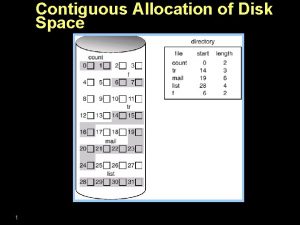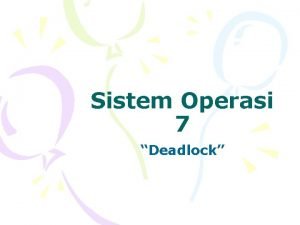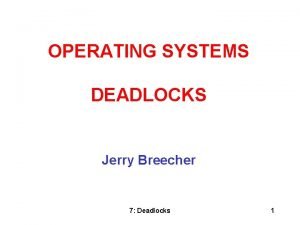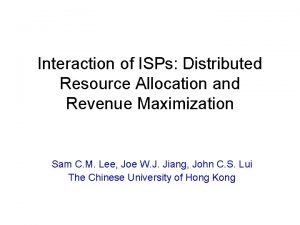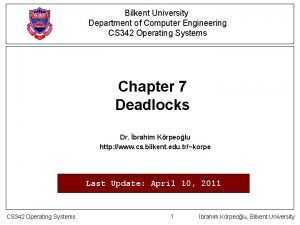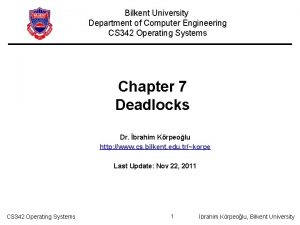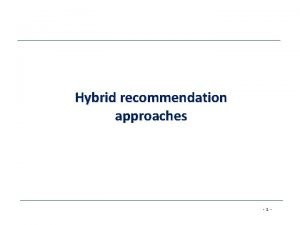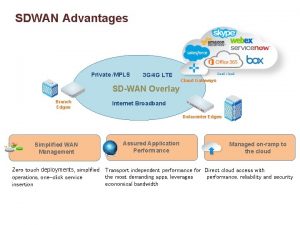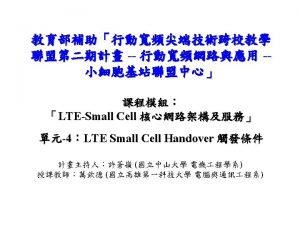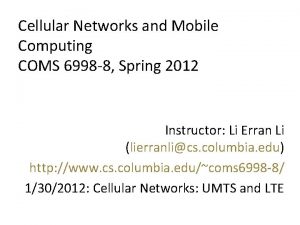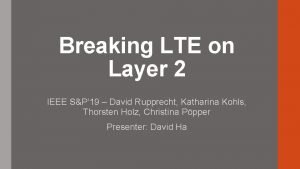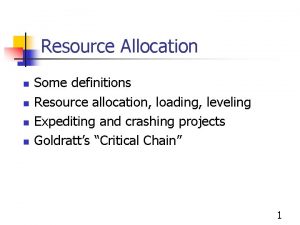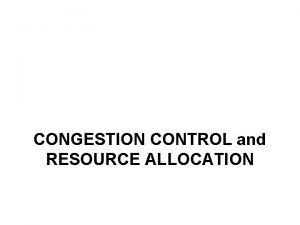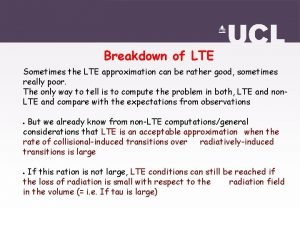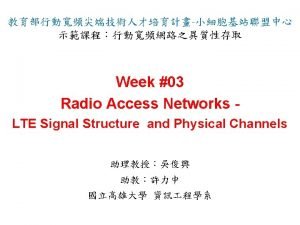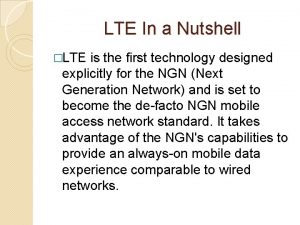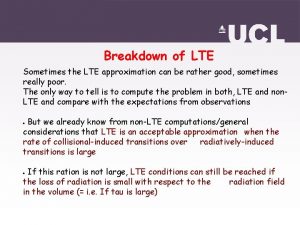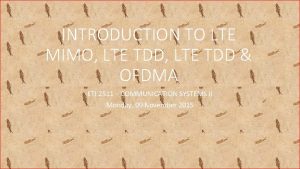SelfOrganized Resource Allocation in LTE Systems with Weighted










![An Online Algorithm for Scheduling • Let ri[t] be the actual throughput of i An Online Algorithm for Scheduling • Let ri[t] be the actual throughput of i](https://slidetodoc.com/presentation_image/ff2cab54476c2493fd68293aafd2cebe/image-11.jpg)












- Slides: 23

Self-Organized Resource Allocation in LTE Systems with Weighted Proportional Fairness I-Hong Hou and Chung Shue Chen

Motivation • 4 G LTE networks are being deployed • With the exponentially increasing number of devices and traffic, centralized control and resource management becomes too costly • A protocol for self-organizing LTE systems is needed

Challenges • LTE employs OFDMA • Link gains can vary from subcarriers to subcarriers due to frequency-selective fading • Need to consider interference between links • A protocol needs to achieve both high performance and fairness

Our Contributions • Propose a model that considers all the challenges in self-organizing LTE networks • Identify three important components • Propose solutions for these components that aim to achieve weighted proportional fairness

Outline • • • System Model and Problem Formulation An algorithm for Packet Scheduling A Heuristic for Power Control A Selfish Strategy for Client Association Simulation Results Conclusion

System Model • A system with a number of base stations and mobile clients that operate in a number of resource blocks • A typical LTE system consists of about 1000 resource blocks • Each client is associated with one base station

Channel Model • Gi, m, z : = the channel gain between client i and base station m on resource block z • Gi, m, z varies with z, so frequency-selective fading is considered

Channel Model • Suppose base station m allocates Pm, z power on resource block z • Received power at i is Gi, m, z. Pm, z • The power can be either signal or interference • SINR of i on z can be hence computed as Interference Signal

Channel Model • Hi, m, z : = data rate of i when m serves it on z • Hi, m, z depends on SINR • Base station m can serve i on any number of resource blocks • øi, m, z : = proportion of time that m serves i on z • Throughput of i:

Problem Formulation • Goal: Achieve weighted proportional fairness • Max (wi : = weight of client) • Choose suitable øi, m, z (Scheduling) • Choose Pm, z (Power Control) • Each client is associated with one base station (Client Association)
![An Online Algorithm for Scheduling Let rit be the actual throughput of i An Online Algorithm for Scheduling • Let ri[t] be the actual throughput of i](https://slidetodoc.com/presentation_image/ff2cab54476c2493fd68293aafd2cebe/image-11.jpg)
An Online Algorithm for Scheduling • Let ri[t] be the actual throughput of i up to time t • Algorithm: at each time t, each base station m schedules i that maximizes wi. Hi, m, z/ri[t] on resource block z • Base stations only need to know information on its clients • The algorithm is fully distributed and can be easily implemented

Optimality of Scheduling Algorithm • Theorem: Fix Power Control and Client Association, • The scheduling algorithm optimally solves Scheduling Problem • Can be extended to consider fast-fading channels

Challenges for Power Control • Find Pm, z that maximizes • Challenges: • The problem is non-convex • Need to consider the channel gains between all base stations and all clients • Need to consider the influence on Scheduling Problem

Relax Conditions • Assume: • The channel gains between a base station m and all its clients are the same, Gm • The channel gains between a base station m and all clients of base station o are the same Gm, o • We can directly obtain the solutions of Scheduling Problem

A Heuristic for Power Control • Propose a gradient-based heuristic • The heuristic converges to a local optimal solution • The heuristic only requires base stations to know local information that is readily available in LTE standards • Can be easily implemented

Client Association Problem • Assume that each client aims to choose the base station that offers most throughput • Consistent with client’s own interest • In a dense network, a client’s decision has little effects to the overall performance of other clients

Estimating Throughput • To know the throughput that a base station offers, client needs to know: • Hi, m, z : throughput on each resource block, can be obtained by measurements • øi, m, z : amount of time client is scheduled • Develop an efficient algorithm that estimates øi, m, z • Solves Client Association Problem

Simulation Topology X 25 X 16 X 9 500 m

Simulation Settings • Channel gains depend on: • Distance • Log-normal shadowing on each frequency • Rayleigh fast fading

Compared Policies • Default – Round-robin for Scheduling – Use the same power on all resource blocks – Associate with the closest base station • Fast Feedback: has instant knowledge of channels • Slow Feedback: only has knowledge on time-average channel qualities

Simulation Results Total Throughput (Mbps) 300 250 200 150 100 50 0 Default Slow Feedback Fast Feedback

Simulation Results 1 0. 9 0. 8 0. 7 CDF 0. 6 0. 5 Default 0. 4 Slow Feedback 0. 3 0. 2 Fast Feedback 0. 1 0 0 2 4 6 Throughput (Mbps) 8 10

Conclusion • We investigate the problem of selforganizing LTE networks • We identify that there are three important components: Scheduling, Power Control, Client Association • We provide solutions for these problems • Simulations show that our protocol provides significant improvement over current Default policy
 Resource allocation vs resource leveling
Resource allocation vs resource leveling Weighted and non weighted codes with example
Weighted and non weighted codes with example Contiguous allocation vs linked allocation
Contiguous allocation vs linked allocation Allocation management software
Allocation management software Algoritmo banchiere
Algoritmo banchiere Resource allocation and scheduling
Resource allocation and scheduling Resource allocation graph and wait for graph
Resource allocation graph and wait for graph Resource allocation graph
Resource allocation graph Deadlock sistem operasi
Deadlock sistem operasi Deadlock
Deadlock Distributed resource allocation
Distributed resource allocation The plan of action that prescribes resource allocation
The plan of action that prescribes resource allocation Resource allocation graph in os
Resource allocation graph in os Resource allocation graph in os
Resource allocation graph in os Cs 342 bilkent
Cs 342 bilkent Weighted hybrid recommender systems
Weighted hybrid recommender systems Perbedaan resource loading dan resource leveling
Perbedaan resource loading dan resource leveling Sd-wan advantages and disadvantages
Sd-wan advantages and disadvantages Mobility mode
Mobility mode Transmit diversity in lte
Transmit diversity in lte Paging in lte
Paging in lte Frame structure in lte
Frame structure in lte Lte layer 2
Lte layer 2 Lte attach procedure
Lte attach procedure


